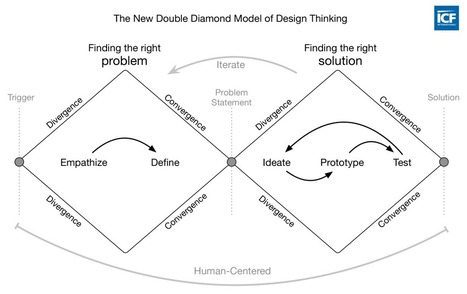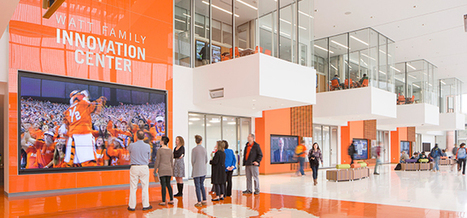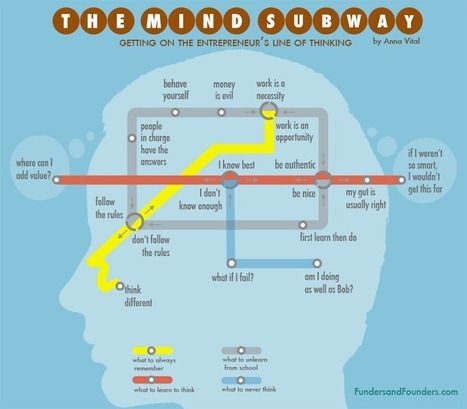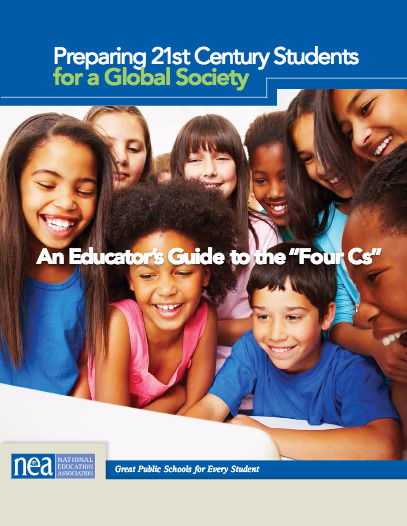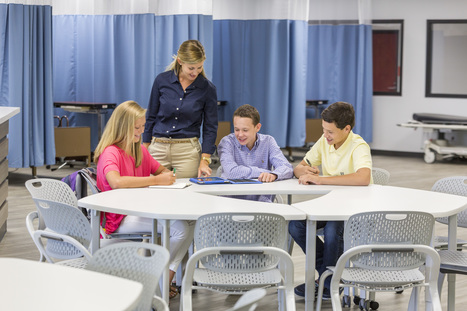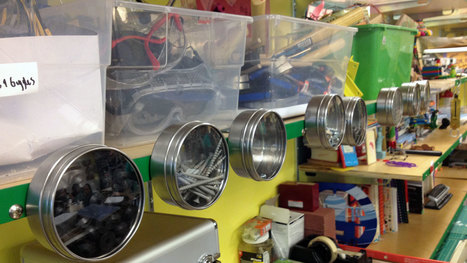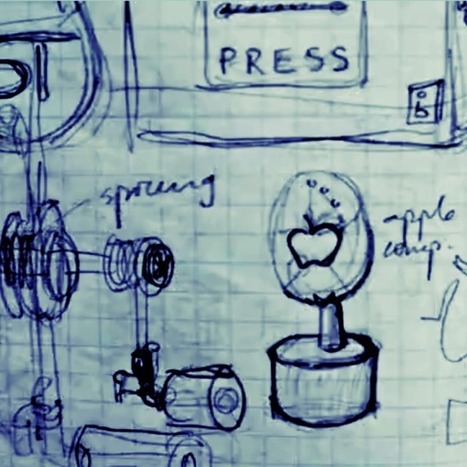 Your new post is loading...
 Your new post is loading...
Observing today’s world can tell us much about tomorrow and what human beings need to meet future challenges. Along with the increasing challenges that we face everyday from economical challenges and climate change to extremism and the increasing language of hate between nations, we should raise a generation that is able to meet these challenges and find innovative solutions for tomorrow’s problems. In a previous article, Can we Apply Design Thinking in Education, we discussed how the current education systems still depend on the some core education pedagogy since decades. Although there is a sustaining innovation in some education systems, these future challenges seek a disruptive innovative that can contribute to building a generation programmed to solve problems rather than dealing with them.
When investigating the different routes to achieve this goal, one route seems to be appealing, as it aims to change how we thinking, which aligns with Albert Einstein’s quote: “You cannot solve a problem with the same mind that created it.” This route is based on design thinking, a methodology that aims to solve problems with a creative approach while putting the user in the center of the process to achieve a user-centered approach. Design thinking processes are not only applied to design business but extend to become a method that can be applied in daily life situation in order to solve our everyday problems or make our lives easier through innovation and creativity.
What is Innovation in Education? Stephen Downes Ghent, Belgium March 30, 2015
Australia’s 40 universities are hotbeds of innovation. They are constantly generating good ideas, based on new research activity across a broad range of disciplines. Government research agencies also generate large amounts of innovative ideas.
At the same time, Australia is experiencing a golden age of startups. New companies are springing up everywhere, driven by a spirit of entrepreneurship and a can-do mood of optimism.
But too many rules can stifle the freedom to try new things
Consider the engineering industry and how difficult it could be to bring new systems, processes and materials to market – in other words, to innovate – if there were no standards.
For innovation to flourish, a framework of standards is needed. This may seem counter-intuitive because innovation is all about creativity and freedom. But without that framework defining and bordering the innovative space, without a room in which to sit and feel safe, innovation becomes near impossible.
A couple of days ago, I was looking for a visual illustration of Design Thinking to share with my colleagues and clients. Thousands of diagrams were found online within a second. However, I was unable to find a single graphic that adequately revealed all essentials of the design thinking process.
Inspiration. Ideation. Implementation.
There are many ways of looking at the stages of the design thinking process. Many experts believe there are 5 stages to design thinking. Some cite 4 or 6. Others 7 or more.
And guess what? They are all probably correct!
And guess what else? I bet that all of them use Inspiration, Ideation, and Implementation in some way, shape, or form for they are the bare bones basic spaces all innovations go through.
Today, I give you the first Infographic in the Hacking Design Thinking For Education Series I am creating. This is Part 1: What Is design Thinking?
Enjoy, use, and abuse it at your own will.
Google Australia has released a report quantifying the benefits to the economy of its many free apps. It reckons that “by connecting consumers and businesses and providing productivity tools, Google helped businesses earn $15.1 billion” in Australia in 2015.
Google says the advantages to consumers are almost as great, at $14.8 billion, and that there are further benefits to society as a whole that are “large but difficult to quantify.” Even if we take the quantified $29.9 billion, that’s a lot of money.
The benefits come in many forms, says the report. The average Australian saves 31 hours a week using Google search, 11 million Australians travel more efficiently using Google Maps, 50,000 businesses use Apps for Work to collaborate and store documents. You get the idea.
Universities today are under more pressure than ever to collaborate with industry.
In the words of Prime Minister Malcolm Turnbull:
Increasing collaboration between businesses, universities and the research sector is absolutely critical for our businesses to remain competitive.
Australia has a poor report card when it comes to university-business collaboration. It ranks last among the OECD countries when comparing the proportion of businesses working with universities.
But this is not all. Australia ranks only 72nd in the world on the Innovation Efficiency Ratio, a measure comparing innovation inputs to outputs. And we have one of the lowest number of scientific publications co-authored by industry in the OECD.
There is a clear impetus for change. A change towards more academic collaboration with industry.
Innovation centers are becoming commonplace on university campuses, but few live up to the name as well as Clemson University's (SC) Watt Family Innovation Center — both in terms of architectural features and the array of technology and collaboration options available to students and faculty. Opened in 2016, the four-story, 70,000-square-foot facility contains 73 spaces with audiovisual tools along with more than 4,300 pieces of hardware provided by 65 different vendors. It has become a natural home for Clemson's Creative Inquiry program, which emphasizes cross-disciplinary collaboration.
“Forget everything you learned,” they told me on the first day of law school. Three years and $150,000 later they erased from my mind all the half-truths I learned from school and my family. They were not teaching law, they acknowledged, they were teaching thinking. As an entrepreneur, you, too, have to relearn everything from scratch. By yourself.
All educators want to help their students succeed in life. What was considered a good education 50 years ago, however, is no longer enough for success in college, career, and citizenship in the 21st century.
download the full document
Preparing 21st Century Students for a Global Society:
An Educator’s Guide to the “Four Cs”
( PDF, 548 KB, 38 pgs.)
The “21st Century Skills” movement is more than a decade old. Yet, educators still pose important questions about how to move 21st century education forward. NEA has been an advocate of the 21st century education movement from its inception and wants to empower educators to move it forward in their own practice.
Ten years ago, NEA helped establish the Partnership for 21st Century Skills (P21) and in 2002 began a two-year journey to develop what became known as a “Framework for 21st Century Learning,” highlighting 18 different skills. In the last eight years, 16 states joined P21 and agreed to build 21st century outcomes into their standards, professional development, and assessments.
Over the years it became clear that the framework was too long and complicated. To resolve this issue, we interviewed leaders of all kinds to determine which of the 21st century skills were the most important for K-12 education. There was near unanimity that four specific skills were the most important. They became known as the “Four Cs”:
critical thinking,
communication,
collaboration, and
creativity.
Alternating your time between two or more creative projects will definitely help your subconscious thinking on each of them!
Your brain is a magical box where once you put things into it and shake it around a bit you’ll be surprised at what comes out. Even if you’re not actively thinking about what you’ve put into it.
But wait a minute: aren’t YOU your brain?
How is it possible that your brain can possibly work on things without you consciously being aware it? What the hell is going on inside the brain to make thinking about something without actually thinking about it possible?
Four Fundamentals for Taking Creative Risks
Sandra Vorensky
Taking risks in a competitive environment can be daunting. In light of international results that rank the United States in the bottom half of developed countries in math achievement among 15-year-olds (PISA, 2012), the prospect of trying new instructional methods is tempered by risk-averse concerns of slipping further in rank. But risk taking in teaching is essential for our nation's students to remain competitive internationally. How can we make room for teacher creativity within the demands of our competitive education culture? Here are four ways to encourage teachers to take creative risks, even in today's education climate.
|
We can’t keep offering the same educational experience to our children and expect different results
Universities are not now, nor have ever been, solely focused on preparing young people for the workforce.
A broad general education, such as an arts or commerce degree, provides young people with a range of capabilities that may be as, or more, relevant to the changing economy than some occupationally specific degrees.
Young people need career advice and workplace experience to develop and apply their skills in an occupational context.
Entrepreneurial skills will be needed if young people are to create their own jobs in the future.
We need to ensure we have the right models of education to suit a range of interests and career aspirations.
For generations, most high schools have been designed with a cookie-cutter approach “that can be reproduced easily,” said Ashley Smith, who works with the architectural firm Smith Design Group. But that’s certainly not true of the new THINC College & Career Academy in LaGrange, Ga., which Smith helped design.
Housed in a building on the campus of West Georgia Technical College, THINC looks nothing like a traditional high school. Instead, it has the look and feel of a Google office building, with brightly colored carpet tiles, lots of glass walls, and stylish furniture that can be moved around easily to create flexible, collaborative workspaces.
Within those spaces, students work in teams to design and build parts for forestry machines, market a college radio station, or even launch their own start-up company. To complete these activities, they use the same technologies that professionals in those fields would use to do their jobs.
The school’s innovative design supports a more modern learning experience, in which students complete hands-on, collaborative projects. It’s a perfect example of active, 21st century learning, where students are fully engaged in their education rather than just passively listening to lectures.
We set out on a quest to learn what makes outside-the-box thinkers tick. And with the help of science we managed to establish few of the traits creative people tend to exhibit.
1. Creative types often have their head in the clouds
2. They are keen observers who are pretty good at analyzing their surroundings
3. There is no daily regimen
4. They love solitude
5. They are constantly looking to try something new
6. They do not shy away from risks
7. For them, failures and mistakes are highly motivating
8. They do stuff that inspires them
9. Creative individuals often put themselves in others’ shoes
10. They notice everything
Sara Diamond is president and vice-chancellor of OCAD University. Karel Vredenburg is director of IBM Design’s worldwide client program and head of IBM Studios Canada.
Never have design thinking, design practice and creative skills been as important to Canada’s future as they are now. Today, competitive success is determined by the ability to understand human needs and desires and to deliver richly imagined ways of addressing them. Many organizations recognize the importance of innovation, but they don’t know how to achieve it. The answer is design.
Designers allow companies to stay ahead of their customers by anticipating and addressing human needs and behaviours in a complex and changing world. Technology needs to be intentionally designed for and with people. Design creates the experience of a product, system or service, the individual, social and cultural experience, and the value and the impact it has. Design is the bridge between raw invention and application.
Curtinnovation is many things: drive, leadership, innovative facilities, technology … the list goes on. This site profiles some of the people, places and experiences that evidence exactly what Curtinnovation is and the amazing results it has precipitated.
Use design thinking (brainstorming, prototyping, testing, building, and reflecting) to co-create your classroom environment with the students who will be learning in it.
Sixth-grade students at Lighthouse Community Charter in Oakland, California, eagerly pull laptops off a cart and settle down with a partner to experiment with Turtle Art, a program meant to introduce them to the basics of programming and some math concepts.
Math teacher Laura Kretschmar gave students a rubric with specific goals around collaboration, communication and instructions to use various functions in the program, but not a lot else. She’s intentionally giving them a lot of freedom to play with the program, create cool designs and figure out what the functions do.
“I think “y” means, like, going up,” says Juritzy Maldonado. “So to pull it up, I’m going to try to change the number.” She punches in 200 for “y” and watches the image she’s creating shift upward. Another group discovers that if they hit “repeat” multiple times, they can create a parachute-like design that they’ve figured out how to color in various ways. That wasn’t their original plan, but they’re running with it now.
Before you eat, you set the table. Before you sell fruit, you create a beautiful display. If you want something to be special, then you have to create the right mood. Before you start your innovation project, your 20time, your Idea Farming, you are going to watch this video. BEFORE you watch the video have students take out paper and pen so that you don’t ruin the mood after the video with five minutes of students searching for paper.
Few can deny that big changes are afoot in higher education. The (still rather new) 21st century has already demonstrated the myriad ways in which education is capable of changing, thanks to novel technologies, ever-more-sophisticated infrastructure, and a willingness to reinvent curricula, course delivery methods and pedagogical training. (Note: this is not intended to be an exhaustive list.)
Where such innovations come from is another story. While edtech companies and educational start-ups aiming to 'disrupt' higher ed from the outside have gained momentum in recent years, some universities have embraced the unknown by creating their own R&D labs for innovation.
Teaching, learning and research aren't mutually exclusive at the University of Michigan.
The university's Office of Digital Education and Innovation is leading a number of projects, with one such 'experiment' among them: a Digital Innovation Greenhouse (DIG), an internal initiative that looks and feels much more like a bustling start-up, where researchers work alongside developers to set the stage for scalable innovations designed specifically for the University of Michigan.
AN EXCITING new collaboration giving support to emerging creative industry workers was launched this week in Perth.
The project is a joint initiative by the City of Perth, Finbar, the Central Institute of Technology, and not-for-profit organisation Guerrilla Creative.
The initiative aims to bridge the gap to employment in a time where the job market is extremely competitive – and to offer a range of services that are not otherwise available.
The City of Perth delivered the space as part of an incentive for developers to include facilities that are available for community use, in which the City offers a bonus 20 per cent plot ratio if a developer provides a facility that benefits the community.
In this case, Finbar’s development at 63 Adelaide Terrace will include a facility for this purpose when it is completed in 2018.
In the meantime, Guerrilla Creative has been given the opportunity to set up shop at a temporary site at 181 Adelaide Terrace, Perth.
Perth City’s Manager of Economic Development Dan High and Scott Cameron from Finbar met with the co-founders of Guerrilla Creative in the lead up to yesterday’s launch.
Indeed, “Innovate or Perish” seems to be a common mantra across many layers of the world of work.
But what might it actually mean, for us in our work in the NPDL Partnership?
One of our four core elements are “New Pedagogical Practices”, aspects of teaching and learning that are (often) enabled, accelerated or amplified by the digital. Whilst there are true opportunities to innovate and extend our teaching and learning here, the notion of building on, or extending current practice through leveraging digital can be one of iteration as opposed to innovation.
So, shifting focus, I would like to share some thinking around the connection between learning partnerships and innovation. It is inspired by a video I came across in that “down-the-rabbit-hole” kind of search that sometimes occurs when you are not really sure what you are looking for, but hope it’s out there!
|

 Your new post is loading...
Your new post is loading...
 Your new post is loading...
Your new post is loading...









